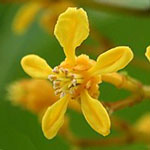
Shrubs or trees; stipules intrapetiolar, 2/3 to completely connate, persistent on petiole; leaves bearing glands on petiole or immersed in abaxial surface of lamina or both. Inflorescence terminal, often pendent, an unbranched raceme of few-flowered cincinni or dichasia or a pseudoraceme of single flowers [1-flowered cincinni]; floriferous peduncles developed; bracteoles persistent, borne at or below apex of peduncle, one or more bearing 1 large terminal or abaxial gland. Sepals leaving outermost petal exposed in enlarging bud, mostly all biglandular with adjacent glands sometimes partially connate (in 1 sp. only the posterior sepals bearing 1–4 glands), the glands borne on or below free part of sepals; corolla bilaterally symmetrical, the posterior petal moderately to strongly differentiated from the lateral 4; petals yellow, dorsalyly keeled or carinate, entire or minutely denticulate, glabrous or minutely pilose on margin; androecium radially symmetrical; stamens glabrous; filaments distinct or slightly connate at base, longer opposite sepals than opposite petals; anthers alike, the outer locules bearing dark longitudinal wings; pollen 3 (4)-colporate, the colpi distally bifurcate in some spp.; receptacle glabrous or with a ring of short basifixed hairs between androecium and gynoecium; gynoecium radially symmetrical; ovary with the carpels 3, connate along a narrow to broad adaxial axis or face; styles 3, slender and subulate with minute stigmas. Cocci dorsally keeled, ventral areole very narrow. Chromosome number: n = 6 (L. lactescens; W. R. Anderson, 1993a); photo.
Three species in Amazonian South America [map]. All the species grow along rivers in wet forests or in sandy open places near rivers, and the cocci are very probably dispersed by water. Indeed, in the only widespread species, L. longifolia, half the volume of each coccus is filled with aerenchyma, surely an adaptation for floating.
Lophanthera and Andersoniodoxa have prominent longitudinal wings on the outer locules of the anthers, found nowhere else in the Galphimia clade (the vesicles on the anthers of Verrucularia may be homologous with those wings). Similar anther wings are found in the genera Acmanthera and Pterandra of the Acmanthera clade, presumably the result of parallel evolution. See Davis et al. (2020a) for a discussion of the position of Lophanthera within the Galphimia clade.
References: W. R. Anderson, 1981b, (pp. 36–42, revision of Lophanthera only: pdf; entire paper 20 MB: pdf).
Etymology: The name Lophanthera comes from the Greek word for crest (lophos) and the Latin word for anther (anthera), from a Greek word for flower (antheros). It refers to the longitudinal wings found on the outer locules of each anther
Uses: Lophanthera lactescens Ducke has become popular in recent decades as an ornamental street tree. The trees grow large and flower copiously, flourishing in cities with badly polluted air, such as Manaus and Rio de Janeiro, which is interesting given the fact that the species is rare in nature, known from only a few collections in Pará, Brazil. Cultivated specimens have been seen from Madre de Dios, Peru, and from the following states of Brazil: Acre, Amazonas, Bahia, Distrito Federal, Espírito Santo, Goiás, Paraná, Rio de Janeiro, and São Paulo.
Photos: pollen; chromosomes; L. lactescens, L. longifolia
Drawing: L. longifolia